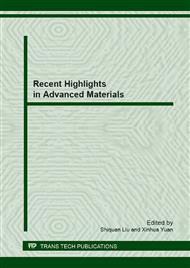[1]
B. Voit, Hyperbranched polymers-All problems solved after 15 years of research, J. Polym. Sci., Part A: Polym. Chem. 43 (2005) 267-273.
DOI: 10.1002/pola.20821
Google Scholar
[2]
C. Gao, D. Yan, Hyperbranched polymers: from synthesis to applications, Prog. Polym. Sci. 29 (2004) 183-275.
Google Scholar
[3]
D. Ratna , G. Simon, Epoxy and hyperbranched polymer blends: Morphology and free volume, J. App. Polym. Sci. 117 (2010) 557-564.
DOI: 10.1002/app.31183
Google Scholar
[4]
D. Foix, X. Ramis, F. Ferrando, A. Serra, Improvement of epoxy thermosets using a thiol-ene based polyester hyperbranched polymer as modifier, Polym. Int. 61 (2012) 727-734.
DOI: 10.1002/pi.3230
Google Scholar
[5]
Song X. J., Luo Y. J., Liu L. Q., Li J, Guo K. Mechanical properties of different end-group modified hyperbranched polyester/HTPB-PU IPN. New Chemical Material. 28 (2010) 61-63.
Google Scholar
[6]
X. J. Song, Y. J. Luo, G. P. Li, C. P. Chai, Synthesis and Mechanical Properties of Hyperbranched Polyether/HTPB Polyurethane Based IPN, Polym. Mater Sci & Eng, 25 (2009) 1-4.
Google Scholar
[7]
E. Malmstroém, M. Johansson, A. Hult, Hyperbranched ali phatic polyesters, Macromolecules. 28 (1995) 1698 - 1703.
DOI: 10.1021/ma00109a049
Google Scholar
[8]
E. Malmstroém, M. Johansson, A. Hult, Effect of core for ming molecules on molecular weight distribution and degree of branching in the synthesis of hy perbranched polymers, Macromolecules. 31 (1998) 239 - 248.
DOI: 10.1021/ma970952y
Google Scholar
[9]
Y. Konno, H. Kudo, A. Kameyama, T. Nishikubo, Synthesis and properties of fluorine-containing polyethers with pendant hydroxyl groups by the polyaddition of bis(epoxide)s with diols. J. Polym. Sci: Part A: Polym Chem. 42 (2004) 2543-2550.
DOI: 10.1002/pola.20074
Google Scholar
[10]
L. Ye, Z. G. Feng, Y. M. Zhao, F. Wu, S. Chen, G. Wang. Synthesis and application as polymer electrolyte of hyperbranched polyether made by cationic ring-opening polymerization of 3-{2-[2-(2-hydroxyethoxy)ethoxy]ethoxymethyl} -3'- methyl -oxetane, J. Polym Sci: Part A: Polym Chem. 44 (2006).
DOI: 10.1002/pola.21450
Google Scholar
[11]
Y. Hong, S. J. Coombs, J. J. Cooper-White, M. E. MacKay, C. J. Hawker, E. Malmström, N. Rehnberg, Film blowing of linear low density polyethylene blended with a novel hyperbranched polymer processing aid, Polymer. 41 (2000) 7705 - 7713.
DOI: 10.1016/s0032-3861(00)00130-0
Google Scholar


